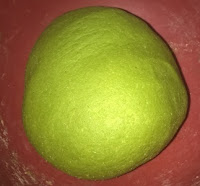Palak Paratha
Palak Paratha is a Flatbread infused with a puree of spinach, green chilly garlic, and ginger. The Dough is made from wheat flour and kneaded with salt, oil, and water. The Dough is then divided into small balls and rolled into thick flatbreads which are then roasted with ghee or butter.
Palak Paratha can be had for breakfast, lunch or dinner. It is a very strengthening form of a flatbread, rich in iron calcium and other minerals. Palak Paratha can be served with a bowl of curd or a bowl of curd salad. It can be also had plain with just a lot of butter.
Parathas are very common in India, specifically the North of India. While Palak means Spinach, Paratha is a Flatbread. Let us now see below the steps involved in the making of the Palak Paratha or Spinach Paratha.
Palak Paratha can be had for breakfast, lunch or dinner. It is a very strengthening form of a flatbread, rich in iron calcium and other minerals. Palak Paratha can be served with a bowl of curd or a bowl of curd salad. It can be also had plain with just a lot of butter.
Parathas are very common in India, specifically the North of India. While Palak means Spinach, Paratha is a Flatbread. Let us now see below the steps involved in the making of the Palak Paratha or Spinach Paratha.
INGREDIENTS
1 and 1/2 Cup Wheat Flour
1 and 1/2 Cup(125 gms) Spinach or Palak Leaves
1 Small Green Chilli, finely chopped
10 Small Garlic Cloves
1/4 Inch of Ginger
1/2 Tsp Salt
2 Tbsps Water
1 Tbsp Oil for kneading
Ghee or Butter for Roasting
1 and 1/2 Cup(125 gms) Spinach or Palak Leaves
1 Small Green Chilli, finely chopped
10 Small Garlic Cloves
1/4 Inch of Ginger
1/2 Tsp Salt
2 Tbsps Water
1 Tbsp Oil for kneading
Ghee or Butter for Roasting
SERVINGS / TIME
6 Parathas / 1 Hour
PREPARATION
1. Wash the spinach leaves thoroughly well. Cut the leaves from the stalks. Keep 10 cloves of garlic, 1/4 inch piece of ginger and salt ready. Add all these ingredients to a blender or a mixer, mix well with very little water, since we will be using this spinach puree to need the dough very little water needs to be used to avoid the dough from getting too soft and sticky. Now your spinach or palak puree is ready.
2. Take 1 and a 1/2 cup wheat flour in a bowl, add a tablespoon of oil and the above spinach or palak puree. Knead to form a nice soft dough. Now keep the dough aside for 30 minutes.
3. Divide the dough into 6 medium sized balls. Taking a rolling pin and roll each ball by sprinkling flour on each side while rolling to prevent the dough from sticking. The dough should be rolled out nice round and thick. Roll out all the balls to a nice round and thick shapes and keep aside for roasting.
4. Heat a pan or a tava on a high flame. When the pan or tava is hot enough add the round and thickly shaped paratha. Once the paratha bubbles on one side, flip it, it should be browned on that side, smear ghee or butter on the center across the paratha.
5. Gently press the paratha with a cotton cloth so that it puffs up. The paratha may not puff up if rolled out thin or if not exposed to enough heat. See that both the sides of the paratha are browned. Clean up the tava or the pan to remove any dry flour before roasting the remaining parathas.
6. Serve the parathas hot. I have placed them in a paratha container, stacking them one above the other so that they remain fresh and can be consumed a little later in the day.
2. Take 1 and a 1/2 cup wheat flour in a bowl, add a tablespoon of oil and the above spinach or palak puree. Knead to form a nice soft dough. Now keep the dough aside for 30 minutes.
3. Divide the dough into 6 medium sized balls. Taking a rolling pin and roll each ball by sprinkling flour on each side while rolling to prevent the dough from sticking. The dough should be rolled out nice round and thick. Roll out all the balls to a nice round and thick shapes and keep aside for roasting.
4. Heat a pan or a tava on a high flame. When the pan or tava is hot enough add the round and thickly shaped paratha. Once the paratha bubbles on one side, flip it, it should be browned on that side, smear ghee or butter on the center across the paratha.
5. Gently press the paratha with a cotton cloth so that it puffs up. The paratha may not puff up if rolled out thin or if not exposed to enough heat. See that both the sides of the paratha are browned. Clean up the tava or the pan to remove any dry flour before roasting the remaining parathas.
6. Serve the parathas hot. I have placed them in a paratha container, stacking them one above the other so that they remain fresh and can be consumed a little later in the day.









Comments
Post a Comment